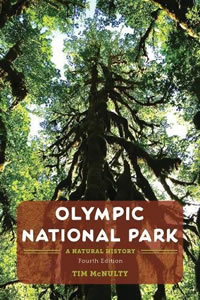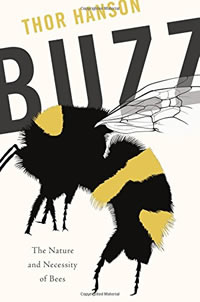 “Olympic National Park: A Natural History” was first published in 1996. Author Tim McNulty and University of Washington Press have now come out with the fourth edition (2018). It’s no wonder this book has been so popular. McNulty is an excellent essayist and the subject is a mostly unspoiled, large-scale ecosystem, from seashore to mountaintops, the latter easily seen on a clear day from Seattle.
“Olympic National Park: A Natural History” was first published in 1996. Author Tim McNulty and University of Washington Press have now come out with the fourth edition (2018). It’s no wonder this book has been so popular. McNulty is an excellent essayist and the subject is a mostly unspoiled, large-scale ecosystem, from seashore to mountaintops, the latter easily seen on a clear day from Seattle.
This is not an identification book or field guide. There are photographs, but they mostly set the mood of the book by being clustered up front. Instead, this a reading book, intended to be savored cover-to-cover, to gain an understanding of the flora and the fauna in broad settings: the mountains, the forests, and the coast. The author concludes with the human history of the region, especially pre-European, and the much more recent struggle to establish and maintain the integrity of the national park and its ecosystems.
This newest edition is the same as the previous (2009) in large part, but includes the story of the removal of dams on the Elwha River. It also updates efforts to restore the animal life as found prior to the influence by European and eastern North American settlers, with the reintroduction of fishers and the removal of non-native mountain goats.
The Olympic Peninsula is sometimes described as a refugia, a place where plant and animal species survived while disappearing from nearby locations. This is in part because of the wide range of topographical niches, caused by extreme changes both in elevation and rainfall over short distances. Species could adapt by moving to nearby, suitable habitats.
Earlier history is part of this story, too. While much of the peninsula avoided glaciation, “the ice age and the climatic upheavals that preceded them have reshuffled the deck of plant and animal communities wildly in the Olympic Mountains…alpine and sub-alpine species mixing willy-nilly with lowland plants and varieties.” This gives hope that these mountains and lowlands will continue to provide refuge for plants during future climate change.
Excerpted fom the Spring 2019 Arboretum Bulletin.
 I was very impressed with the story-telling skills of Thor Hanson that I discovered when reading his “The Triumph of Seeds” (see review in the Fall 2015 issue of the “Bulletin”). He makes scientific research easy to understand and an adventure that’s fun!
I was very impressed with the story-telling skills of Thor Hanson that I discovered when reading his “The Triumph of Seeds” (see review in the Fall 2015 issue of the “Bulletin”). He makes scientific research easy to understand and an adventure that’s fun! Fascinated by all the small life forms you find in your garden? Perhaps not, but it is still valuable for gardeners to know about them. “Pacific Northwest Insects” by Merrill Peterson will help. This excellent new field guide provides incredible color photos of over 1,200 species native to our region. The scope is the phylum Arthropoda, so this includes all the true insects (bees, beetles, butterflies, flies, etc.) plus centipedes, sow bugs, spider mites, and even spiders and ticks (yikes!).
Fascinated by all the small life forms you find in your garden? Perhaps not, but it is still valuable for gardeners to know about them. “Pacific Northwest Insects” by Merrill Peterson will help. This excellent new field guide provides incredible color photos of over 1,200 species native to our region. The scope is the phylum Arthropoda, so this includes all the true insects (bees, beetles, butterflies, flies, etc.) plus centipedes, sow bugs, spider mites, and even spiders and ticks (yikes!).![[The Brother Gardeners] cover](https://depts.washington.edu/hortlib/graphix/brothergardeners.jpg)
 “Designing with Palms” by Jason Dewees is by a San Francisco based author, who profiles garden motifs evoked by palms across the country. For instance, Chamaerops humilis suggests a Mediterranean garrigue, an ecosystem with low shrubs, including rosemary and lavender, like one might find in a Seattle landscape.
“Designing with Palms” by Jason Dewees is by a San Francisco based author, who profiles garden motifs evoked by palms across the country. For instance, Chamaerops humilis suggests a Mediterranean garrigue, an ecosystem with low shrubs, including rosemary and lavender, like one might find in a Seattle landscape.![[The Organic Profit] cover](https://depts.washington.edu/hortlib/graphix/organicprofit.jpg)
![[Flora of Middle Earth] cover](https://depts.washington.edu/hortlib/graphix/floraofmiddle-earth.jpg)
![[Flora of the Pacific Northwest] cover](https://depts.washington.edu/hortlib/graphix/floraofthePacificNorthwestfull.jpg)
![[book title] cover](https://depts.washington.edu/hortlib/graphix/AbernethyForest.jpg)